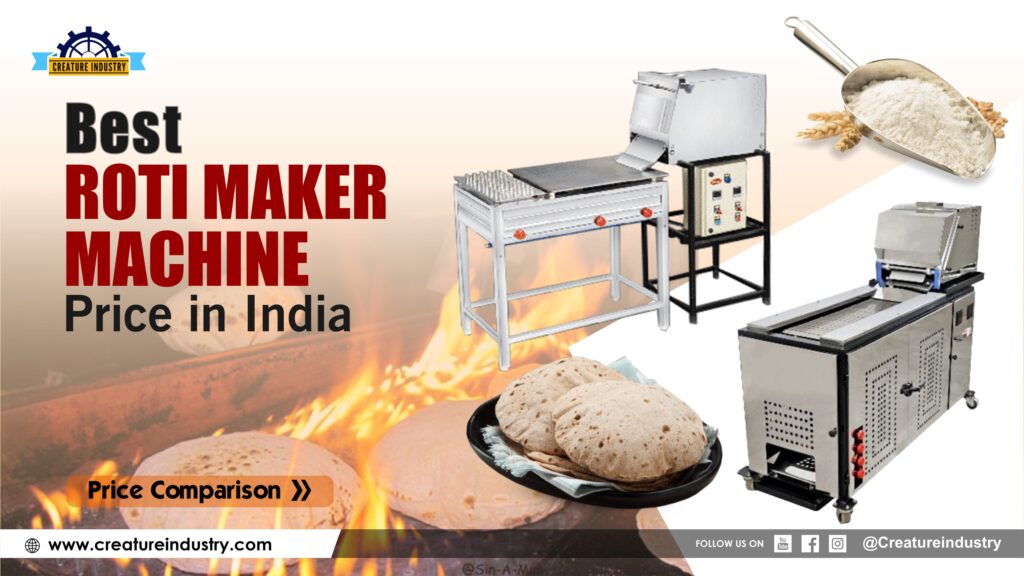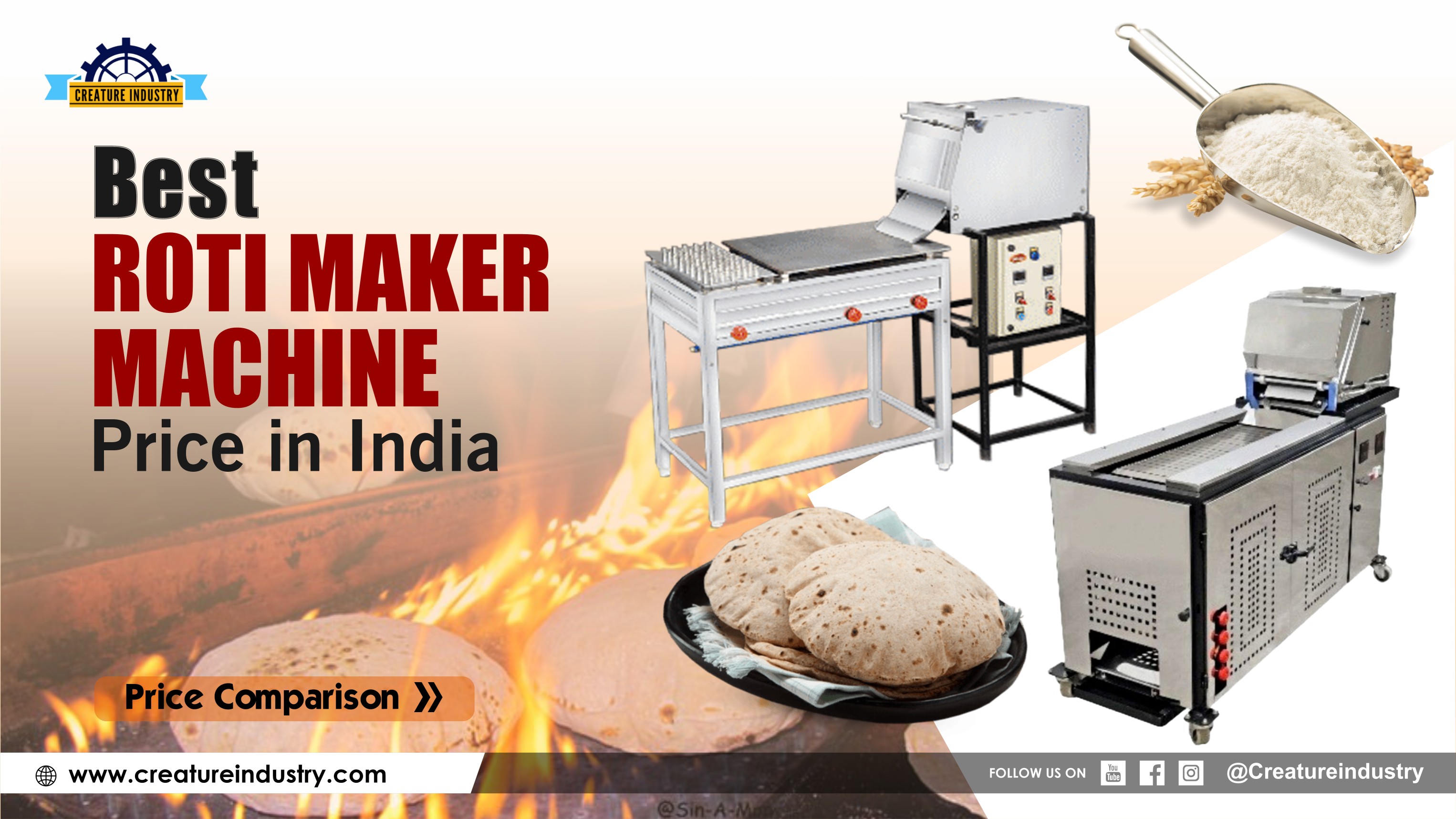The roti maker machine has revolutionized modern kitchens, making it easier than ever to prepare soft and fluffy rotis with minimal effort. Whether you are a busy professional, a homemaker, or someone looking for convenience in cooking, a roti maker can be a game-changer. In this comprehensive guide, we will discuss everything about roti maker machines, their benefits, features, buying guide, and maintenance tips.

Page Contents
What is a Roti Maker Machine?
A roti maker machine is an innovative kitchen appliance designed to automate the process of making rotis, chapatis, and even other flatbreads like tortillas and parathas. It works by pressing and cooking the dough into perfectly round and evenly cooked rotis using non-stick heating plates.
Benefits of Using a Roti Maker Machine
1. Saves Time and Effort
One of the primary advantages of a roti maker is its ability to produce rotis quickly. Instead of manually rolling, flattening, and cooking each roti, the machine automates these steps, reducing cooking time significantly.
2. Consistent Size and Shape
Manually making rotis often results in irregular shapes and inconsistent sizes. A roti maker ensures uniformity, producing evenly cooked rotis every time.
3. Energy Efficient
Unlike traditional gas stoves, modern roti maker machines consume less energy, making them an eco-friendly choice.
4. Easy to Use
Even beginners can make perfect rotis using a roti maker. Most models come with simple temperature control settings and an easy-to-operate pressing mechanism.
5. Healthier Cooking
With non-stick surfaces, roti makers require less oil or ghee, promoting healthier eating habits.
How Does a Roti Maker Work?
A roti maker machine functions through an electric-powered heating mechanism. The dough ball is placed between two non-stick plates, which press and cook the roti evenly. The heating plates generate the required heat, ensuring quick and effective cooking.
Types of Roti Maker Machines
1. Manual Roti Maker
A manual roti maker is a simple device that requires pressing the dough manually while cooking it on a hot surface. These models are more affordable but require more effort compared to electric ones.
2. Automatic Roti Maker
Automatic roti makers are more advanced and feature temperature control, automatic pressing, and cooking functions. They are highly efficient and ideal for daily use.
3. Commercial Roti Maker
Designed for restaurants and large-scale operations, commercial roti makers can produce multiple rotis at once, saving time and labor costs.
Key Features to Look for in a Roti Maker
1. Non-Stick Coating
A good roti maker machine should have a high-quality non-stick coating to prevent the dough from sticking and ensure even cooking.
2. Adjustable Temperature Control
Different dough types require different temperature settings. A roti maker with adjustable temperature control provides better cooking flexibility.
3. Shockproof Body
For safety reasons, ensure the machine has a shockproof body and heat-resistant handles.
4. Indicator Lights
Indicator lights signal when the machine is preheated and ready for use, making operation easier.
5. Compact and Lightweight Design
A compact and lightweight design ensures easy storage and portability.
How to Use a Roti Maker Machine Effectively
- Prepare Soft Dough – The dough for a roti maker should be softer than traditional hand-rolled dough for better results.
- Preheat the Roti Maker – Always allow the machine to preheat before placing the dough.
- Use the Right Dough Size – Place a small, round ball of dough in the center of the lower plate.
- Close and Press – Gently press the upper plate onto the dough for a few seconds.
- Cook Evenly – Flip the roti once it starts puffing up and let it cook until done.
- Serve Fresh – For the best taste and texture, consume the rotis fresh and hot.
Maintenance and Cleaning Tips
- Unplug Before Cleaning – Always unplug the roti maker before cleaning to ensure safety.
- Use a Damp Cloth – Wipe the non-stick plates with a damp cloth instead of using harsh scrubbers.
- Avoid Water Contact with Electrical Parts – Never immerse the machine in water to prevent electrical damage.
- Store in a Dry Place – Store the machine in a dry place to prevent rust and damage.
Price Range of Roti Maker Machines
The price of automatic roti maker machines varies based on factors like capacity, features, and automation level. Here’s a general price range:
- Semi-Automatic Roti Maker – ₹13,000 to ₹25,000
- Fully Automatic Roti Maker – ₹30,000 to ₹55,000
- Industrial Roti Making Machines – ₹60,000 and above
Factors Affecting Roti Maker Machine Price
- Capacity & Output – Machines with higher output cost more.
- Automation Level – Fully automatic machines are pricier than semi-automatic ones.
- Material & Build Quality – Stainless steel models last longer but are costlier.
- Brand & Features – Advanced features like temperature control and dough pressing impact pricing.
Top Roti Maker Models in 2025
1. Prestige PRM 3.0 Roti Maker
Key Features:
- Non-stick coating for easy roti release
- Stainless steel body for durability
- Adjustable temperature control
- Power indicator for safety
2. Bajaj Vacco Go-Ezzee Roti Maker
Key Features:
- Shockproof stainless steel body
- High-quality non-stick surface
- Automatic temperature control
- Energy-efficient operation
3. Sunflame RM1 Roti Maker
Key Features:
- Durable and lightweight design
- Uniform heating for evenly cooked rotis
- Easy-to-use handle press
- Compact and space-saving
4. Eveready RM1001 Roti Maker
Key Features:
- Heavy-duty non-stick plates
- Cool-touch handle for safety
- Quick heating for faster cooking
- Easy to clean and maintain
5. Hilton Roti Maker
Key Features:
- Sleek design with a durable build
- Multi-purpose use (can make parathas, khakras, and rotis)
- Adjustable heat settings
- Energy-efficient performance
How to Choose the Best Roti Maker?
When selecting a roti maker, consider the following factors:
- Non-Stick Surface: Ensures the roti does not stick and cooks evenly.
- Temperature Control: Adjustable settings help in achieving the perfect texture.
- Build Quality: Stainless steel bodies are more durable and long-lasting.
- Ease of Use: Look for a model with a comfortable handle and simple controls.
- Safety Features: Shockproof design and cool-touch handles ensure safe operation.
Top Roti Maker Brands in the Market
- Prestige Roti Maker – Known for its durable build and efficient heating mechanism.
- Bajaj Vacco Roti Maker – Popular for its affordability and quality performance.
- Sunflame Roti Maker – Features a stylish design with user-friendly operations.
- Jaipan Roti Maker – Offers high efficiency and a robust non-stick coating.
- Wonderchef Roti Maker – A premium choice with advanced heating technology.
Common Issues and Troubleshooting Tips
1. Roti Sticking to the Surface
- Solution: Apply a thin layer of oil or flour to prevent sticking.
2. Rotis Not Puffing Up
- Solution: Ensure the dough is soft and properly kneaded. Adjust the temperature settings if needed.
3. Machine Overheating
- Solution: Allow the machine to cool between uses to prevent overheating.
4. Uneven Cooking
- Solution: Always place the dough ball in the center and press evenly.
Conclusion
A roti maker machine is a valuable addition to any kitchen, making the process of preparing rotis faster and more efficient. With the right model, proper usage, and maintenance, you can enjoy perfectly cooked rotis every time. Investing in a high-quality roti maker ensures convenience, consistency, and healthier meals for you and your family.
Frequently Asked Questions (FAQs)
1. Is a roti maker worth buying?
Yes, a roti maker saves time, ensures uniform rotis, and is a great investment for busy individuals and families.
2. Can I make other flatbreads using a roti maker?
Yes, apart from rotis, you can make chapatis, tortillas, parathas, and even dosas with some models.
3. Why do my rotis turn hard in the roti maker?
Hard rotis can be due to dry dough. Ensure your dough is soft and let it rest before making rotis.
4. How do I clean my roti maker?
Use a damp cloth to wipe the surface after unplugging. Avoid using harsh scrubbers.
5. Can I use oil in a roti maker?
Yes, applying a little oil can prevent sticking and improve the texture of the rotis.
6. How long does it take to make a roti in a roti maker?
It typically takes about 1-2 minutes per roti, depending on the model and settings.

